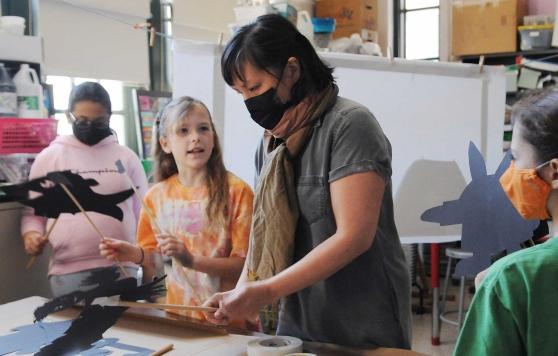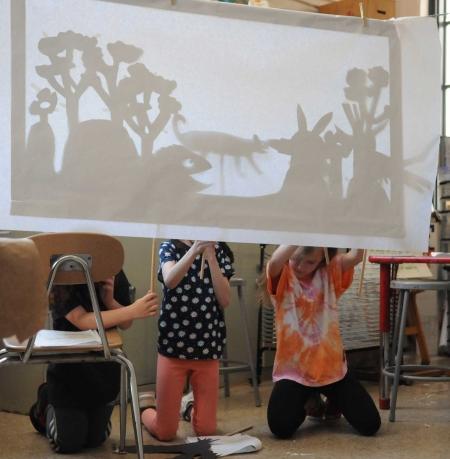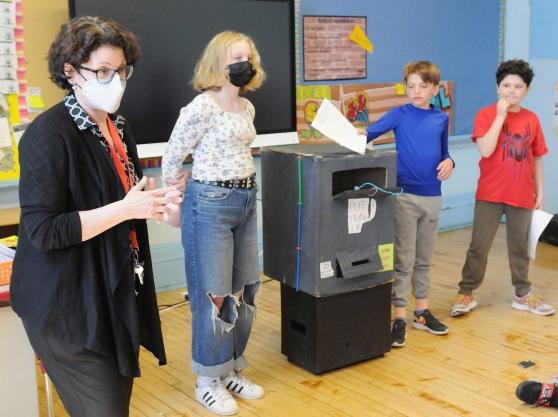The art of collaboration

Art teacher Priscilla Shen helps 4th-graders prepare their shadow puppets.
After a trio of 5th-graders acted out a scene in which one student was “attacked” by an animal and used a special device to call for help, another student listed the product’s specifications and then belted out a jingle.
“When you’re in a tricky situation/and you need some alert-ation/of the hard predicament you’re in/Mini Danger Guardian is always there/Mini Danger Guardian is always there, always there,” the student sang.
Collaboration among three arts teachers and their classes at PS 295 in Brooklyn led to the 90-second commercial for a prototype of a watch that would make loud noises, display flashing lights, call 911 and more. The students came up with the idea and designed the product in Priscilla Shen’s art class, composed the jingle in Andy Laster’s music class and wrote a script and acted out the commercial in Caitlin Barton-Landfield’s drama class.
Barton-Landfield and Shen had worked together before on school plays, but they had long wanted to team up on cross-curricular creative projects. With the return of fully in-person learning this school year, they wanted to engage their 4th- and 5th-graders and get them collaborating in ways that weren’t possible during the COVID-19 pandemic.
Many students spent two years of their lives not really doing group work, Shen said. “So, it was challenging, but it was very needed.”
Shen and Barton-Landfield’s three 4th-grade sections developed shadow puppetry shows. The teachers used three folk tales that were adapted and illustrated by children’s book author Gerald McDermott.
During a rehearsal in May, 4th-graders kneeled behind a white sheet that was suspended on a string in the art room. They held their puppets and props directly behind the sheet so the audience could see them in shadow, practicing their six-scene adaptation of “Zomo the Rabbit: A Trickster Tale from West Africa.” Working with Barton-Landfield, students added their own dialogue and narration to the Nigerian fable, even tacking on a final scene in which the leopard, cow and fish that Zomo tricked catch up to the rabbit and demand they be given back their fish scales, tooth and milk.
“Wait, wait, wait, wait, wait, wait, wait! It wasn’t me. I wouldn’t do that. It wasn’t my fault. I would never, ever, ever, ever, ever, ever do something like that!” the student playing the rabbit pleaded unconvincingly.
The 5th-graders’ assignment was to invent a product that would solve a problem in society — such as hunger, poverty or safety issues — and create a commercial and a jingle. The projects had to be aligned with universal design principles, whose objective is to ensure environments, products and communications are accessible to the most people possible.
In music class, Laster used software including digital audio workstations Audacity, Soundtrap and Hookpad Musical Sketchpad to help students record and edit the jingles. He was trained on Audacity and Soundtrap during the pandemic. “This is one of those examples where all the remote experience from the last two years is a really positive thing,” he said.
Both teacher-developed curriculums include skill-building in multiple areas outside art, music and drama — including brainstorming, scriptwriting, revising, analyzing, problem-solving and collaborating. The projects also gave students who may struggle academically a chance to shine.
Shen said the arts need to be integrated with all aspects of the curriculum. “Arts are part of the solution,” she said.
Laster said he enjoys project-based learning and the students do, too. “They’re more engaged because it’s a project and it’s something they really want to do,” he said.
Both projects included aspects of diversity, equity and inclusion principles. The shadow puppet shows are based on folk tales from different people of color and different parts of the world. The primary goals of universal design include equity and ease of use, regardless of background and language skills. “It’s something that’s very important to us,” Shen said.
Working out schedules so she and Shen had opportunities to co-teach was challenging, Barton-Landfield said, with both veteran educators giving up some prep and lunch periods to make it work. But they said the sacrifice was worth it.
“This, to me,” Barton-Landfield said, “is the most fulfilling work — creating, thinking outside the box, bringing people with you, bringing students with you, going beyond. And still, this is completely educational.”

